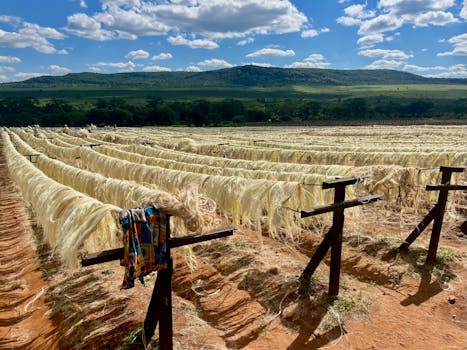Natural Fibers, Global Markets: Africa’s Role in the Sustainable Textile Revolution

Natural Fibers, Global Markets: Africa’s Role in the Sustainable Textile Revolution
Focus Keyword: Natural Fibers
Natural fibers are becoming increasingly popular in the global textile market, and Africa is playing a significant role in this trend. The continent is home to a wide range of natural fibers, including cotton, jute, sisal, and hemp, which are in high demand globally. These fibers are not only sustainable but also offer a unique set of properties that make them ideal for a variety of textile applications.
The global natural fiber market is expected to grow significantly in the coming years, driven by increasing demand for sustainable and eco-friendly textiles. Africa is well-positioned to take advantage of this trend, with its abundant natural resources and growing textile industry. The continent’s natural fibers are being used to create a wide range of sustainable textiles, from clothing and accessories to home furnishings and industrial textiles.
Africa’s Natural Fiber Industry
Africa’s natural fiber industry is diverse and widespread, with different countries specializing in different types of fibers. For example, Egypt is a major producer of cotton, while Kenya is known for its sisal production. The Democratic Republic of Congo is also a significant producer of cotton, while South Africa is home to a thriving hemp industry.
The African natural fiber industry is not only providing economic benefits to the continent but also creating jobs and stimulating local economies. Many small-scale farmers and artisans are involved in the production and processing of natural fibers, which is helping to promote rural development and reduce poverty.
Sustainable Textile Production
Sustainable textile production is a key aspect of the natural fiber industry in Africa. Many textile manufacturers on the continent are adopting sustainable production practices, such as using organic farming methods, reducing water and energy consumption, and implementing recycling programs.
One of the most significant challenges facing the African textile industry is the lack of access to modern technology and infrastructure. However, this is also creating opportunities for innovation and investment, as companies and governments look to develop new and sustainable textile production methods.
Global Market Trends
The global natural fiber market is driven by a range of factors, including consumer demand for sustainable textiles, government regulations, and technological advancements. The market is expected to grow significantly in the coming years, with the global natural fiber market projected to reach $54.3 billion by 2025.
Africa is well-positioned to take advantage of this trend, with its abundant natural resources and growing textile industry. The continent’s natural fibers are being used to create a wide range of sustainable textiles, from clothing and accessories to home furnishings and industrial textiles.
In conclusion, Africa is playing a significant role in the sustainable textile revolution, with its abundant natural fibers and growing textile industry. The continent’s natural fibers are in high demand globally, and are being used to create sustainable textiles that are not only good for the environment but also offer a unique set of properties that make them ideal for a variety of textile applications.